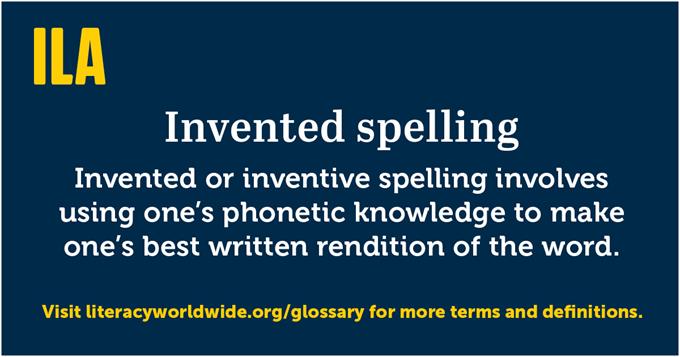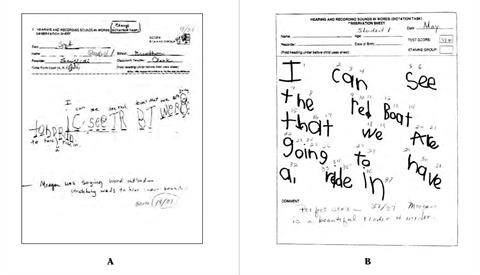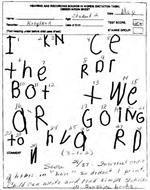 In these stressful times, focusing on our main literacy goal for kindergartners—learning the alphabetic principle, which is the foundational skill of all writing and reading—is essential.
In these stressful times, focusing on our main literacy goal for kindergartners—learning the alphabetic principle, which is the foundational skill of all writing and reading—is essential.
ILA’s Literacy Glossary defines alphabetic principle as the concept that letters or groups of letters in alphabetic orthographies (i.e., written systems) represent the phonemes (sounds) of spoken language.
Four decades ago, Carol Chomsky encouraged preschool, kindergarten, and first graders to try to write before they read because of the valuable practice they received from translating sound to print. Around that time, Charles Read demonstrated that some young children made up the spellings of the words they speak by listening to the individual sounds (phonemes) in words and then attempting to find written letters (graphemes) to represent those phonemes. Connecting sounds to letters in this manner is called invented spelling. Invented spelling not only helps develop the alphabetic principle but also is the best predictor of reading according to Charles Temple and colleagues, Donald Bear and colleagues, and Marie Clay.

Promoting invented spelling
As a literacy consultant who has worked in more than 100 kindergarten classrooms over the past 34 years, I have found that teachers understand students actively construct their own literacy learning about phoneme–grapheme correspondences when they engage in the process of meaningful writing of their own choosing. However, this leads educators to seek out ways to help their students write with inventing spelling.
Invented spelling can be challenging when students write random strings of symbols or mix numbers and shapes with mock letters. To help this issue, I devised Getting Ready, a daily learning structure that should precede writers’ workshop. Getting Ready uses two song strategies and three sound–letter connecting strategies.
Getting Ready: Two song strategies
The first song strategy, ABC Song Strategy, helps students find—and, when ready, write—letters of their choosing. It is sung to the tune of “Twinkle, Twinkle Little Star” and requires both an ABC chart for class use and individual ABC strips for each student to use as they write independently.
The second song strategy, The Name Song, helps students hear beginning individual sounds in spoken words (phonemic awareness). It is sung to the tune of “Skip to My Lou.” I begin teaching this strategy with sound matching by having students try to match the sound I say with the beginning sound in one of their classmate’s names.
When most of the class can successfully sound match, I proceed to sound isolation, which is basically a reverse of sound matching: I say a student’s name and the student’s classmates must isolate the first sound in the name. Students love playing with their classmates’ names like this.
Getting Ready: Three sound–letter connecting strategies
After kindergartners can isolate individual beginning sounds in classmate’s names, I proceed to teach three sound–letter connecting strategies.
The first strategy shown in the video clip is Connecting Sound to Picture. Students isolate the beginning sound in a classmate's name and then look for a picture on the class ABC chart that begins with the same matching sound.
The second strategy shown is Connecting Sound to Letter Name. Students isolate the beginning sound in a classmate's name and then look at the class ABC chart and try to find a letter name that has the same sound.
The third strategy shown is Connecting Sound to Classmate's Name. Students isolate the beginning sound in a classmate's name and then connect the sound to the first letter of that classmate's name.
I have observed kindergartners using these strategies on their own as they attempt to write in writers’ workshop. Continuing to guide students as they practice these strategies though the use of daily writing workshop conferences is most helpful.
Verify the value
To prove these strategies improve kindergartners’ understanding of the alphabetic principle, I use Clay’s Dictation Test as found in Clay’s An Observation Survey of Early Literacy Achievement. This test is designed to check a student’s ability to hear individual sounds in words. However, it also checks the student’s understanding of the alphabetic principle.
When Clay’s Dictation Test is administered individually to kindergartners, they attempt to write what they hear in the following sentence as it is read aloud very slowly:
I can see the red boat that we are going to have a ride in.
One point is scored for each sound heard and recorded appropriately as a letter. A perfect score is 37.
The following images, which are copies of tests I administered to students myself, show results from the student who scored the highest of the class (19/37) at the beginning of the year (image A) and who had a perfect score (37/37) at the end of the year (image B).

Compare this with the progress of the student who scored the lowest in the class (0/37) at the beginning of the year (test not shown). This student improved significantly (28/37) by the end of the year (see below).

Notice the progress both students have made. That the rest of the kindergarten class was equally successful and scored somewhere between a 28 and 37 on Clay’s Dictation Test is worth noting.
The results of Clay’s Dictation Test verify that all 20 students in this kindergarten class could write with invented spelling, which demonstrates an understanding of sound–letter relationships, the alphabetic principle. All these students became writer–readers.
I have seen similar results across the many kindergarten classes where writers’ workshop and the Getting Ready strategy were used as I have described. Knowledge of the alphabetical principle allows every student to be a writer–reader, and the strategies I have described are a highly effective way to teach it.
Arlene C. Schulze is a longtime reading teacher and specialist. She holds a degree in elementary education from the University of Wisconsin, Madison, and a master's degree in reading from the University of Wisconsin, Stevens Point (UWSP).
She has been a K–2 literacy consultant to three school systems in North Central Wisconsin and a literacy instructor in reading and language arts at UWSP for many years. She is the author of the book Helping Children Become Readers Through Writing: A Guide to Writing Workshop in Kindergarten. She is currently coaching kindergarten teachers and tutoring struggling readers in northern Wisconsin.